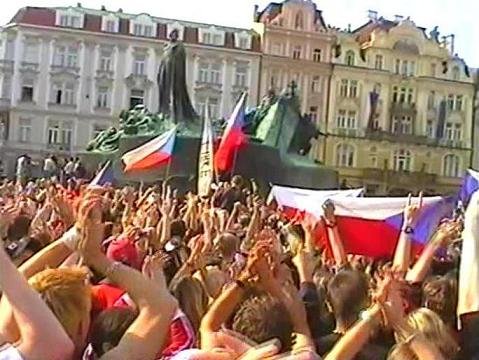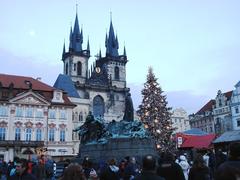
Jan Hus Memorial Prague: Visiting Hours, Tickets, and Historical Significance
Date: 14/06/2025
Introduction: A Landmark of Czech Identity and Reform
Standing in the heart of Prague’s Old Town Square, the Jan Hus Memorial is much more than a work of art—it’s a prominent emblem of Czech national identity, religious reform, and cultural resilience. Erected in 1915 on the 500th anniversary of Jan Hus’s martyrdom, the monument honors the life and influence of Jan Hus (c. 1370–1415), a pioneering Czech religious reformer. His commitment to preaching in the Czech language and his bold defiance against ecclesiastical corruption sparked the Hussite Wars and profoundly shaped both Czech and European history. The memorial, sculpted by Ladislav Šaloun, was a crowning achievement of the Czech National Revival, symbolizing resistance to foreign domination and the enduring spirit of Czech culture (Prague.eu, Britannica, Tours-Prague.eu).
The Jan Hus Memorial is freely accessible at any hour, inviting locals and visitors alike to reflect on its historic and cultural significance amidst the vibrant backdrop of Old Town Square. Annual commemorations, particularly on July 6 for Jan Hus Day, highlight its ongoing role as a living symbol of remembrance and national unity.
This guide provides comprehensive details on the history, symbolism, visitor information, nearby attractions, and practical tips to enrich your experience of this Prague landmark.
Table of Contents
- Historical Background
- Visitor Information
- Inscriptions and Symbolic Messages
- Legacy and Continuing Significance
- Frequently Asked Questions
- Plan Your Visit
- References
Historical Background
Jan Hus and the Bohemian Reform Movement
Jan Hus emerged from humble beginnings in Husinec, Bohemia, to become a leading figure of reform at Charles University in Prague. Influenced by John Wycliffe’s writings, Hus delivered sermons in Czech at Bethlehem Chapel, filling the church with audiences eager for reform (Britannica, Tours-Prague.eu). He denounced the Church’s moral decay, opposed the sale of indulgences, and challenged the dominance of foreign clergy, intertwining religious critique with a nationalistic defense of Czech culture.
Martyrdom and the Hussite Wars
Excommunicated for his views, Hus was summoned to the Council of Constance in 1414 under a promise of safe conduct. There, he refused to recant and was burned at the stake on July 6, 1415 (Britannica, Prague.cz). His execution triggered widespread unrest, igniting the Hussite Wars (1419–1434) and inspiring future reformers, including Martin Luther. The Hussite movement not only reshaped Czech society but also prefigured the Protestant Reformation (WiseVisitor).
The Czech National Revival and the Memorial
The Czech National Revival of the 19th and early 20th centuries revived Hus’s legacy as a symbol of national pride and resistance to Habsburg and other foreign influences. Calls for a public memorial began in 1891, culminating in a design competition in 1900. Ladislav Šaloun’s visionary approach won public support, and the monument was funded entirely by popular donations (LivingPrague.com).
Design, Symbolism, and Construction
Šaloun’s Art Nouveau and Symbolist masterpiece, completed in 1915, features:
- Jan Hus: Standing resolutely above a burning stake, gazing toward the Church of Our Lady before Týn.
- Victorious Hussite Warriors: Symbolizing those who fought for religious reform.
- Exiled Protestants: Representing forced exile after the 1620 Battle of White Mountain.
- Young Mother: Embodying national rebirth and hope.
The granite pedestal intentionally covers the site of the old gallows, and the monument’s orientation strengthens its connection to Prague’s Hussite heritage (Prague.eu, Pragitecture.eu).
Visitor Information
Visiting Hours and Admission
- Open: 24 hours a day, year-round.
- Admission: Free; no ticket required.
The Jan Hus Memorial is an outdoor monument, making it accessible at any time. Nighttime illumination offers a unique perspective for evening visitors.
Accessibility
- Location: Old Town Square (Staroměstské náměstí), Prague.
- Access: Flat, paved surfaces; suitable for wheelchairs and strollers.
- Public Transport: Staroměstská metro station (Line A) and tram stops nearby.
Getting There
- Metro: Staroměstská (Line A), 5-minute walk.
- Tram: Stops at Staroměstská or Náměstí Republiky.
- Parking: Limited; public transport or walking recommended.
Best Times to Visit
- Quietest: Early mornings (before 9:00) and late evenings (after 20:00).
- Peak: May–September, from 10:00–18:00.
- Photography: Best light early or late in the day.
Nearby Attractions
- Church of Our Lady before Týn: Iconic Gothic church facing the memorial.
- Astronomical Clock (Orloj): Medieval marvel on the Old Town Hall tower.
- Kinský Palace: Art exhibitions in an 18th-century setting.
- Charles Bridge: Historic pedestrian bridge across the Vltava River.
Guided Tours and Special Events
- Guided Walking Tours: Include the Jan Hus Memorial and broader Old Town history.
- Annual Commemorations: July 6 (Jan Hus Day) with ceremonies and cultural events.
- Audio Guides: Available via mobile apps and local tourism resources.
Inscriptions and Symbolic Messages
The memorial’s inscriptions, added after 1918, reflect Czech aspirations and Hus’s ideals:
- “Love each other and wish the truth to everyone” (Jan Hus)
- “Live, nation sacred in God, don’t die”
- “Who are the warriors of God and his law” (from the Hussite anthem)
- “I believe, that the anger thunders will cease and that the government of your affairs will return to your hands, Czech folk” (Prague.cz)
Legacy and Continuing Significance
Today, the Jan Hus Memorial is a protected national cultural monument, central to Czech identity and collective memory. It stands as a powerful reminder of the Czech people’s historic struggles for religious freedom, justice, and self-determination. Its presence in Old Town Square continues to inspire commemorations and public gatherings, especially during Jan Hus Day (WiseVisitor, Prague.eu).
Frequently Asked Questions
Q: Is there an entrance fee?
A: No, the Jan Hus Memorial is free to visit 24/7.
Q: Is the site accessible for those with mobility challenges?
A: Yes, the area is flat and paved, accessible to wheelchairs and strollers.
Q: Are guided tours available?
A: Yes, many walking tours of Old Town include the memorial. Audio guides are also available.
Q: When is Jan Hus Day celebrated?
A: July 6, marked with ceremonies and cultural events at the memorial.
Q: What other sites can I visit nearby?
A: Church of Our Lady before Týn, Astronomical Clock, Kinský Palace, and Charles Bridge are all within short walking distance.
Plan Your Visit
- Duration: 15–30 minutes for the memorial; longer if combining with nearby sites.
- Tours: Book through local operators or official Prague tourism websites.
- Amenities: Cafes, restrooms, and shops are available around Old Town Square.
- Tips: Visit early or late for fewer crowds; dress for the season; check for special events.
- Safety: The area is safe and well-patrolled, but keep an eye on personal belongings during busy times.
For immersive audio tours and up-to-date visitor information, download the Audiala app.
References
- Britannica
- Tours-Prague.eu
- Prague.eu
- LivingPrague.com
- WiseVisitor
- SpottingHistory
- Prague Guide
- PragueGo
- Pragitecture.eu
- Nomads Travel Guide
- Life Globe
- Fotoeins Fotografie
- Prague’s Best Places
- View from Prague























































































































































































